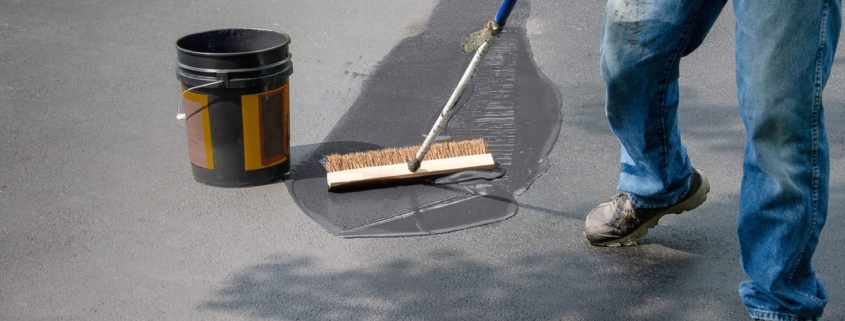Your Guide to Smooth Asphalt Repairs
From the tell-tale signs of asphalt wear and tear to the more complex underlying problems causing them, it can be a challenge knowing where to start with asphalt repairs. Read this guide to explore the quick fixes and preventative measures that can make your pavement problems a thing of the past. Time to dive in and pave the way to smoother asphalt surfaces!
Keeping Your Asphalt in Top Shape: Preventative Maintenance Strategies
Don’t wait for potholes before you start thinking about asphalt repairs. Being proactive about your asphalt maintenance can save you from headaches and hefty repair costs down the road. Preventative maintenance is the key to extending the life of your asphalt and keeping it looking as good as new. Here’s how to stay ahead of the game:
Routine Inspections and Monitoring
Like any good relationship, keeping an eye on your asphalt periodically is essential. Regular inspections and monitoring help catch problems before they balloon into major repairs. Walk the stretch of your pavement; look out for early signs of wear and tear, like small cracks or drainage issues. Early detection is your best defense against major repairs.
Sealcoating: Benefits and Optimal Frequency
Think of seal coating as sunscreen for your asphalt. It provides a protective layer that wards off harmful UV rays, water penetration, and chemical spills. But just like sunscreen, it needs to be reapplied regularly. Sealcoating should typically be done every two to three years, but the exact timing can vary based on traffic and weather conditions. This preventative step is a must-do to keep your pavement smooth and resilient.
Crack Filling as a Preemptive Step
Cracks in asphalt aren’t just unsightly—they’re an open invitation for water to seep in and cause more extensive damage. Crack filling not only improves the appearance of your driveway or parking lot but also extends its lifespan. Address those little cracks promptly. It’s a small action that prevents big problems.
Importance of Timely Response to Minor Issues
Ever heard the saying “A stitch in time saves nine”? When it comes to asphalt, a proactive repair in time could save you bundles over time. Addressing minor issues promptly can mean the difference between a simple fix now and a costly overhaul later. If you see something, do something—it’s the smart way to manage your pavement’s health.
Implement these preventative maintenance strategies for asphalt and watch your roads, driveways, and parking spaces reward you with years of smooth, trouble-free service. Remember, the best time to repair your asphalt was yesterday—the next best time is now!
Is It Worth Fixing? Asphalt Repairs vs. Complete Overhauls
Deciding between repairing your asphalt surfaces or opting for a complete replacement can be a major decision. It’s important to consider both the present condition and the expected longevity of your asphalt to determine the most cost-effective solution. Let’s explore the financial and practical factors you need to consider.
Assessing the Condition: Repair or Overhaul?
Before pulling out your wallet, take a hard look at your pavement. Are there just a few cracks, or is the damage widespread? Small fractures typically suggest that repairs will be enough, while severe crumbling or erosion might indicate the need for an overhaul. It’s a balancing act between the current state and future expectations.
Financial Impacts: Short-term Outlay vs. Long-term Savings
- Repair costs are generally lower and can extend the life of your asphalt without the need for a full redo. However, continuous small repairs may add up over time.
- Replacement is a significant initial investment but can mean fewer headaches and expenses down the line, leading to potential long-term savings.
Project Timelines and Minimizing Disruptions
Time is money, and this rings true for asphalt projects, too. Repair jobs are usually quicker and might not disrupt your business operations or daily routines extensively. A replacement project will take more time, potentially impacting your operations. Consider not just the fiscal cost but also the cost of inconvenience.
Weighing these aspects carefully can guide you to the right decision for your property, pocket, and peace of mind. Remember, strategic investments today can lead to substantial savings tomorrow.
Do you need asphalt repairs in or around the Kansas City region? Contact Phillips Paving today to schedule an inspection.
Contact UsComprehensive Asphalt Repair Methods
Whether you’re facing minor wear and tear or full-on craters, there’s a repair method to match. Let’s dive into some of the most effective ways to mend that trusty tarmac under your tires.
Patching: A Quick Fix for Smaller Issues
Do you have some pesky potholes or small areas begging for attention? Patching is your go-to quick fix. This method is like slapping on a band-aid—easy, efficient, and it’ll hold up just enough to get you by until a more thorough solution is necessary.
Overlaying: Adding a New Layer to Existing Asphalt
If your asphalt has good bones but is showing its age on the surface, overlaying may be the perfect makeover. This method involves pouring a fresh new layer of asphalt right over the old, giving it a smooth, fresh finish without the hassle of a complete do-over.
Full-Depth Repair for Serious Damage
Now, when we’re talking about deep structural woes, full-depth repair is the best option. This technique means removing sections of damaged asphalt all the way down to the base and then rebuilding from the ground up.
Choosing the Right Method for Your Project
It’s crucial to choose the right method that fits the specific needs of your pavement. Factors like the extent of the damage, your budget, and future plans for the area should all weigh into your decision. A well-chosen repair can extend the life of your asphalt and keep your wallet from running on empty.
- Patching is great for quick, cost-effective fixes to minor problems.
- Overlaying breathes new life into old asphalt without breaking the bank.
- Full-depth repair is your best bet when dealing with serious structural damage.
Now that you’re savvy on the options, it’s time to roll up your sleeves and get down to business—or better yet, bring in a pro like Phillips Paving to make sure the job’s done right.
Master the Seasons: Timely Asphalt Maintenance Tips
Every season brings its own set of challenges, especially when it comes to maintaining your asphalt surfaces. In the ever-changing climate of Kansas City, it’s critical to plan your asphalt repair and maintenance with the weather in mind.
Temperature Fluctuations: Planning Ahead in Kansas City
As Midwesterners know, temperatures can swing dramatically between extremes. These fluctuations can have a profound effect on asphalt by causing it to expand and contract, potentially leading to cracks and other types of damage. To protect your pavement, it’s essential to understand these patterns and plan maintenance activities accordingly.
Best Seasons for Asphalt Repairs and Maintenance
If you’re wondering what is the best time of year for asphalt repairs, here are a few tips:
- Spring: As the snow melts, it’s the perfect opportunity to assess and repair damage inflicted by the winter months. Spring is also ideal for seal coating to protect asphalt from upcoming heat and UV rays.
- Summer: Warm temperatures and clear skies make summer the prime time for most asphalt repair projects, including crack filling and resurfacing.
- Fall: Take advantage of the mild weather to prepare your asphalt for the harsh winter conditions ahead with proactive maintenance.
It’s generally best to avoid major repairs during the winter when cold temperatures can hinder proper curing and adhesion of repair materials. However, emergency patching can be done if necessary.
Combatting Snow, Ice, and Winter Damage on Asphalt Surfaces
Winter, with its snow and ice, poses unique challenges to asphalt. The cycle of freezing and thawing can widen existing cracks and create new ones, weakening the surface. Here’s how to manage winter damage:
- Be proactive: Fill cracks and seal coat asphalt before winter to minimize water penetration.
- Choose the right deicing agents: Some chemicals can damage asphalt. Use safer alternatives like calcium magnesium acetate.
- Regular snow removal: Keeping your asphalt clear of snow and ice reduces moisture and limits damage.
Caring for your asphalt all year round ensures it remains durable and reliable. By understanding the demands of each season, you can plan effective maintenance and enjoy smooth, trouble-free surfaces no matter the weather.
The Impact of Asphalt Conditions on Property Value
When it comes to maintaining your property’s appeal and value, don’t overlook the importance of the asphalt that ushers visitors to your doorstep. First impressions matter, and the state of your driveways and walkways invites (or repels) pedestrians, guests, customers, and employees to your property. Let’s explore how pristine asphalt can roll out the welcome mat to not only visitors but also potential buyers, influencing property value more than you might expect.
First Impressions: The Role of Driveways and Walkways
Imagine approaching a property for the first time. What strikes you first? Often, it’s the pathway that leads you in. A cracked and neglected driveway can signal a lack of care, while a smooth, well-kept asphalt surface suggests meticulous attention to detail. This curb appeal is not just about aesthetics—it’s a testament to the property owner’s commitment to preservation and quality.
The Ripple Effect of Well-Maintained Asphalt on Overall Value
It’s not just about the immediate wow factor. Well-maintained asphalt indicates fewer future repairs, less hassle, and a readiness to use. This assurance can translate into tangible financial gains. Properties boasting immaculate exteriors, including asphalt, often fetch higher market values and sell quicker. On the other hand, the hint of impending asphalt repairs can be a deterrent to potential buyers, possibly lowering the property’s perceived value.
Quantifying Curb Appeal
While the visual appeal of a flawless driveway is evident, quantifying it in terms of property value can be a bit challenging. However, real estate experts often agree that properties with clean, attractive exteriors can see a significant increase in value. In fact, some estimates suggest that effective curb appeal, which includes the condition of your asphalt, can boost property value by 5 to 10 percent.
- Properly maintained asphalt signals to potential buyers that the property is well-cared for.
- Properties with attractive exteriors, including driveways and walkways, often have a higher perceived value.
- Investing in asphalt maintenance can result in a valuable increase in overall property worth.
Keep Your Pavement Prime With Proactive Asphalt Care From Phillips Paving
Maintaining your asphalt shouldn’t be an afterthought. Proactive measures not only extend the life of your pavement but also prevent minor issues from turning into costly problems. From minor asphalt driveway repairs to more extensive full-depth projects, don’t wait for the damage to spread. Get in touch with Phillips Paving for an inspection or a project quote today. We’ll help you pave the way to durable, good-as-new asphalt.




